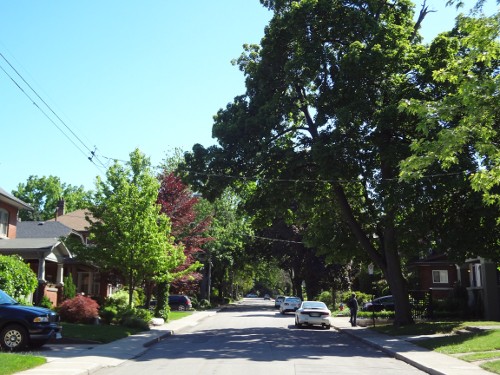The City is currently undertaking the development of an strategy to measure, protect and expand the city's urban forest.
By Jason Allen
Published June 20, 2019
Wednesday night at the Huntington Park Recreation centre was the latest installment in the ongoing three-year development of an urban forestry strategy for the city of Hamilton.

Urban tree canopy in southwest Hamilton (RTH file photo)
It may surprise you to know that there is no strategy currently in place, an oversight which is being rectified by this process. However, it may also surprise you to know that the city really has very little understanding of our urban forest (read: trees), including how many there are, and what species are present.
To back up a little, the last comprehensive inventory of Hamilton's urban forest happened in 2009, a lifetime ago in the history of a forest. So that meant that when the time came to gather data for this strategy, the city had to basically start from scratch. Engaging a consultant and a piece of software called i-Tree Eco, they set out to map a representative sample of the canopy in Hamilton.
They arrived at a few interesting facts. Extrapolating from their sample, Hamilton's urban canopy comprises about 21 percent of Hamilton's surface, an area covered with tree canopy leaves in the summer. The target for the city's Official Plan is 25 percent and the target for the forestry department (don't ask me why the two don't align) is 30 percent. So the city has a ways to go.
Also of note was the fact that about 60 percent of our tree canopy is on private land (this will matter more later), despite being no longer planted, invasive Norway Maples make up about 19 percent of the canopy, and about 25 percent of the leaf area comes from four invasive species: Manitoba Maple, Norway Maple, Black Locust and Buckthorn.
One member of my breakout group confessed to the manager of forestry at our table that she had "a buckthorn problem", to which he replied ruefully, "Everybody has a buckthorn problem."
With that, the city has proposed six goals and accompanying actions to increase the tree canopy and health of the urban forest.
They are:
Plan and Act - incorporate the urban forestry guidelines into planning decisions
Protect - ensure existing trees are well taken care of, including a controversial potential measure.
Plant - set targets for how many trees are needed and plant them in a reasonable time frame in order to reach the target canopy cover.
Maintain - ensure a process exists for maintaining the urban forest, and continuing to gather data and monitor its health.
Communicate - educate the public and city departments as to the value and importance of urban trees.
Monitor and Adapt - set long-term goals for a strategy review, and use an evidence-based approach (nearly every one of these goals' proposed actions included gathering data) to ensure long-term viability.
The plan in general seems sound, and as mentioned is highly data-driven and evidence-based. That means the urban forestry department will be going to Council with a recommendation for a forestry data management tool, and will likely be securing i-Tree Eco permanently to continue to map the urban canopy in its entirety.
The controversial proposal, which will be very interesting to get past a largely developer-friendly City Council, is the notion of a private tree by-law. While still in early exploration phase, the idea would be to protect or at least restrict the removal of trees on private property, including those in back yards of single-family dwellings that currently have no protection at all.
Much of the conversation from participants throughout the evening made mention of developers, including the one who not too long ago cut down a number of healthy mature trees to make room for a development, and received a slap on the wrist in terms of a fine.
Many people there felt that enforcement would be a key part of the success of any private tree by-law, and that the city's current complaint-based practice of responding to infractions would do nothing to protect trees from homeowners, who could just cut down their tree and face a fine if someone bothered to call in a complaint.
Clearly the consultants and the urban forestry group have more work to do, prior to bringing such a strategy before council. Indeed the plan is to draft a final report, and then possibly open it up to public comment prior to it going to council in December of this year or January of next.
In the end though, it would seem that a strategy for managing the health of our urban forest in a world steadily being rocked by climate change bringing invasive plants and insects, heat, drought and other negative effects can't come a moment too soon.
The final session of this round of consultation is this coming Monday, June 24, 6:30 PM at Bernie Morelli Recreation Centre.
By ScreamingViking (registered) | Posted June 29, 2019 at 16:15:55 in reply to Comment 129964
You've seen detailed construction plans? Awesome. Please share!!!
You must be logged in to comment.
There are no upcoming events right now.
Why not post one?